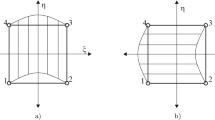Abstract
The weight function method is applied to solving three-dimensional linear elastic fracture mechanics (LEFM) problems. Within the framework of the present approach the fundamental equations of LEFM are satisfied and the minimum of additional assumptions are used.
The crack opening displacement field and stress intensity factors for a semi-elliptical surface crack in the nonuniform stress fields are obtained. Comparison of the calculated results with the numerical data from the literature confirms the efficiency of the proposed method for the solution of three-dimensional crack problems.
Zusammenfassung
Die Gewichtsfunktionsmethode wird für die Lösung dreidimensionaler Aussgaben der linearen Bruchmechanik gebraucht.
Im Rahmen der vorgeschlagenen Methode werden fundamentale Gleichungen der linearen Bruchmechanik befriedigt und nur minimale Anzahl der Zuschlagsvermutungen benutzt. Es wird gefunden die Ausdrücke für Verschiebungen der Risskanten und die Bedeutungen der Spannungsintensitätsfaktoren bei ungleichartiger Belastung für halbelliptischen Riss im Halbraum.
Der Vergleich der Ergebnisse vorliegender Arbeit mit bekannten Zahlenangaben hat die Effektivität der vorgeschlagenen Methode für die Lösung dreidimensionaler Aufgaben der linearen Bruchmechanik gezeigt.
Résumé
La méthode des fonctions pondérées est appliquée à la solution de problèmes de mécanique de rupture linéaire et élastique (MRLE) à trois dimensions. Dans le cadre de la présente approche, on satisfait aux équations fondamentales de la MRLE et l'on recourt à un minimum d'hypothèses supplémentaires. On obtient le champ de déplacement d'ouverture de la fissure et les facteurs d'intensité des contraintes pour une fissure de surface semi-elliptique, pour des champs de contraintes non uniformes. En comparant les résultats du calcul avec les données numériques en provenance de la littérature, on confirme l'efficacité de la méthode proposée pour solutionner les problèmes de fissuration sur trois dimensions.
Similar content being viewed by others
References
G.C. Sih, Handbook of Stress Intensity Factors, Bethlehem (1973).
R.C. Shah and A.S. Kobayashi, Engineering Fracture Mechanics 3 (1971) 71–96.
A.E. Andreykiw, Three-dimensional Problems of Crack Theory, Kiev, Naukova Dumka (1982) (in Russian).
V.A. Vainshtok, Problemy Prochnosti 3 (1984) 29–34 (in Russian).
J.C. NewmanJr. and I.R. Raju, Engineering Fracture Mechanics 15 (1981) 185–192.
R.C. Shah and A.S. Kobayashi, in Stress Analysis and Growth of Cracks, ASTM STP 513 (1972) 3–21.
G.G. Chell, Engineering Fracture Mechanics 8 (1976) 331–340.
H.F. Bueckner, in Methods of Analysis and Solutions of Crack Problems, Mechanics of Fracture, 1, Noordhoff (1973) 131–178.
J.R. Rice, International Journal of Solids and Structures 8 (1972) 751–758.
X.R. Wu and J. Carlsson, Journal of Mechanics and Physics of Solids 31 (1983) 485–497.
P. Morawietz, C. Mattheck and D. Munz, International Journal of Numerical Methods in Engineering 21 (1985) 1487–1497.
C. Mattheck, P. Morawietz and D. Munz, International Journal of Fracture 23 (1983) 201–212.
V.A. Vainshtok, Problemy Prochnosti 6 (1986) 25–28 (in Russian).
V.A. Vainshtok and I.V. Varfolomeyev, Problemy Prochnosti 8 (1986) 18–24 (in Russian).
H.J. Petroski and J.D. Achenbach, Engineering Fracture Mechanics 10 (1978) 257–266.
T.W. Orange, in Stress Analysis and Growth of Cracks, ASTM STP 513 (1972) 71–78.
G.C. Sih and H. Liebowitz, in Fracture 2, An Advanced Treatise, Academic Press (1968) 67–190.
R.P. Hartranft and G.C. Sih, in Methods of Analysis and Solutions of Crack Problems. Mechanics of Fracture, 1, Noordhoff (1973) 179–238.
J.P. Benthem and W.T. Koiter, in Methods of Analysis and Solutions of Crack Problems. Mechanics of Fracture, 1, Noordhoff (1973) 131–178.
G.G. Chell, Engineering Fracture Mechanics 7 (1975) 137–152.
K. Hayashi and H. Abe, International Journal of Fracture 16 (1980) 275–285.
Author information
Authors and Affiliations
Rights and permissions
About this article
Cite this article
Vainshtok, V.A., Varfolomeyev, I.V. Application of the weight function method for determining stress intensity factors of semi-elliptical cracks. Int J Fract 35, 175–186 (1987). https://doi.org/10.1007/BF00015587
Received:
Accepted:
Issue Date:
DOI: https://doi.org/10.1007/BF00015587




